Beauty Re-envisioned – Repurposed Kuba Cloth
PRIMITIVE - Friday, June 06, 2014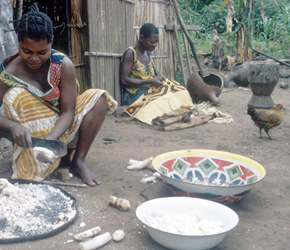 |
|
|
Photo credit: Eliot Elisofon |
By Misaki Imagawa
I imagine one of the most challenging aspects of collecting and presenting rare, antique items is how to present them in a way that enhances appreciation. Just recently we were challenged to consider novel and innovative ways of repurposing Kuba cloth for a contemporary home. This African textile, while aesthetically very pleasing and easy to appreciate, is difficult to display due to its sheer length – at times reaching beyond twenty feet. How then could this highly collectible textile be “re-envisioned,” or to put it another way, presented in a meaningful and aesthetically pleasing way?
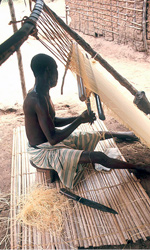 |
|
Deep inside the Democratic Republic of Congo in Central Africa is the Kuba Kingdom. There, men and women work side by side to create highly symbolic cloths, known simply as Kuba cloth. The cloth is fabricated from the leaf of the raffia palm tree, the plant with the longest leaves in the world. The transformation from leaf to textile is easy to understand, but difficult to execute. Discarded leaves are gathered, dried, softened, dyed, and stripped down to individual fibers before being woven into panels or strips that are then embroidered. Typical panels measure approximately 26 x 28 inches square. These units are then sewn expertly together to create the great length of a wrap-around skirt.
All of this is a collaborative effort between Kuba artisans, but teamwork isn’t what makes Kuba cloth so valuable and collectible. Instead, it is the stunning abstract geometric designs embroidered on the finished cloth. The designs embroidered or appliquéd on the cloth is a visual language highly appreciated by all in Kuba society. Some say this visual script emerged from tribal scarification patterns, crop patterns, or even divine intervention. Regardless of their origins, the patterns have been passed down through generations; and while this patterning can be repetitive, or even spontaneous, it is always unique.
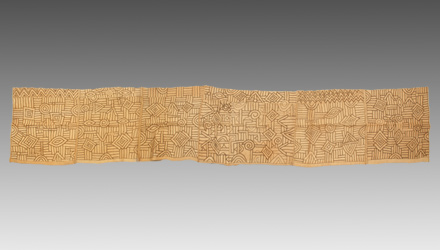 |
In the past, PRIMITIVE has found inventive ways to repurpose Kuba cloth. Most notably, it was backed and used as upholstery for chairs and benches. This simple application transformed basic shapes into stunning works of art; yet it obscured the true nature of the cloth as a collectible textile. Now, we found another way of repurposing the cloth so its unmistakable design can be fully appreciated as a stand-alone work of wall-art – a tapestry reconstituted from the original, long cloth.
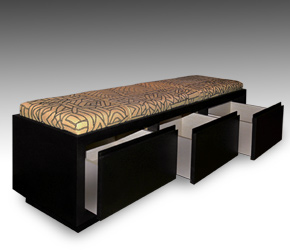 |
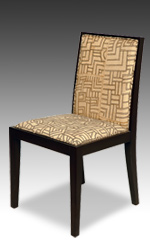 |
Due to the separate units or squares comprising the cloth, it was possible to separate and recombine them into unique visual compositions. They were then backed and a pocket was added for a suspension bar. The art of rearranging the panels into a size more suitable for wall hanging gives the viewer the opportunity to perceive, at a glance, the colors and dynamics of the patterns. The subtle differences in shades brought an element of contrast to the piece that was both decorative and harmonious. The finished tapestry produced a powerful effect of intimacy between the viewer and the majesty of the Kuba cloth itself. This was, we realized, what we had been striving for all along – a preservation of the original dialogue embedded in this ceremonial textile that would allow collectors a chance to appreciate them in their entirety.
This finished piece provides a modern application to the classic beauty, tradition and craft of the Kuba people. Seeing just a small section of this greater artistry compels you to look at the balance of colors and at each stitch, some of which are uneven or crooked – attractive imperfections that drive home the fact that these were meticulously made by the hand and the heart.
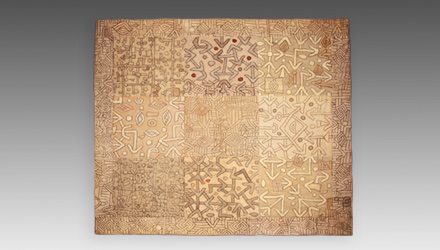
|
|
Download this Article: Beauty Re-envisioned.pdf